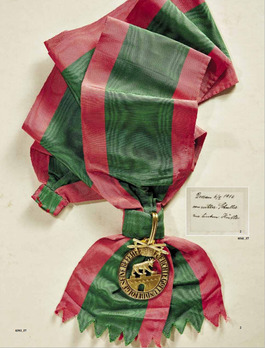Order of Albert the Bear, Grand Cross with Swords
SKU: 01.ANH.0101.201.01
Estimated market value:

Estimated market value:
Attributes
Physical Description
An ovular medal constructed of bronze gilt, silver gilt, or gold. The centre of the medal bears the cut out image of a crowned bear ascending a wall with a door. The obverse is encompassed with a border inscribed with "FUERCHTE GOTT UND BEFOLGE SEINE BEFEHLE" (Fear God and Obey His Commands). The reverse is encompassed by a border inscribed with "ALBRECHT DER BAER REG: 1123 BIS 1170" (Albert the Bear reign of 1123 to 1170). The medal is topped with two crossed swords. On a loop for suspension on a red and green sash.
There are examples of the Grand Cross with Swords topped with a crown.
History
The Order of Albert the Bear was founded by Prince Sigismund I of Anhalt-Dessau around 1382 and was named after Albert the Bear (1110-1170), the first Ascanian Margrave of Brandenburg and the Count of Anhalt and Ballenstadt. The order was forgotten after Prince Sigismund I’s death in 1405. On November 18, 1836, the order was renewed and made a joint House Order by Duke Henry of Anhalt-Köthen, Duke Leopold IV of Anhalt-Dessau, and Duke Carl of Anhalt-Bernburg. The Order of Albert the Bear was awarded by the Dukes to meritorious subjects as a token of honour and distinction.
The Order of Albert the Bear originally featured three main grades and two merit medals, which included: Grand Cross with Grand Cross Breast Star, Commander, Knight, Gold Medal of Merit, and Silver Medal of Merit. In 1848, the grade of Commander was expanded into I Class Commander with I Class Commander Breast Star and II Class Commander. In 1854, the grade of Knight was expanded into I Class Knight and II Class Knight. From 1863, the reigning Duke of Anhalt was the order’s Grand Master. Non-Christians were not eligible for the order until after 1863.
The Order was amended on July 18, 1864, to incorporate crossed swords as a possible addition for wartime merit. The crossed swords, which are added between the top of the medal and the suspension ring, indicate a Military Division award. The absence of crossed swords indicates a Civil Division award.
In 1901, a surmounting gold-coloured crown was added to the grades of Grand Cross, I Class Commander, II Class Commander, and I Class Knight. A surmounting silver crown was added to the grade of II Class Knight.
According to the statutes, it was possible for a Grand Cross to be awarded with the combination of a crown and swords, however, no such medal was officially produced.
There are only 12 examples of the Grand Cross that were made from pure gold. These were intended for an elite group of people, which included: Kaiser Ferdinand of Austria, King Friedrich Wilhelm III of Prussia, and Tsar Nicholas I of Russia.

Versions
$2,300 USD
Bronze gilt
Obv: FUERCHTE GOTT UND BEFOLGE SEINE BEFEHLE Rev: ALBRECHT DER BAER REG: 1123 BIS 1170
44x52mm
This version is constructed of bronze gilt.
$2,300 USD
Silver gilt
Obv: FUERCHTE GOTT UND BEFOLGE SEINE BEFEHLE Rev: ALBRECHT DER BAER REG: 1123 BIS 1170
44x52mm
This version is constructed of silver gilt. The Grand Cross with Swords in silver gilt is not an officially produced medal; however, ...
$3,000 USD
Gold
Obv: FUERCHTE GOTT UND BEFOLGE SEINE BEFEHLE Rev: ALBRECHT DER BAER REG: 1123 BIS 1170
44x52mm
This version is constructed of gold. There are only 12 examples of the Grand Cross that were made from pure gold. These were intended f...
$2,800 USD
Bronze gilt
Obv: FUERCHTE GOTT UND BEFOLGE SEINE BEFEHLE Rev: ALBRECHT DER BAER REG: 1123 BIS 1170
42x83mm; 33x30mm (crown)
This version is constructed of bronze gilt and the swords are topped with a royal crown. There were no official examples of this medal ...


Comments
Sign in to comment and reply.


Scroll Top